Erik Larson Books Ranked
An author's whose works I refer to as nonfiction novels.
Introduction
Over the past few months, I’ve been working my way through Erik Larson’s bestselling books. Larson is a very popular author right now and he primarily writes historical nonfiction books. It’s important to call his books what they are though. In my opinion, they are closer to novels than most historical texts. Larson is adept at putting a speculative gloss over all of the facts and figures to make his stories compelling for today’s readers.
The result isn’t bad. In fact his books are, for the most part, really good. However, they do bend and blur the line between fiction and non. I’d refer to his books (only amongst us friends) as nonfiction novels. The speculative gloss coating his stories is thinner than historical fiction, but far too thick to call them purely historical.
Who would want to read a nonfiction novel? If you’re like me and strongly prefer reading fiction, but you sometimes want to go on a horizon-expanding adventure into nonfiction, then Larson’s books are likely a good fit for you. They have all the narrative and character of a novel, but also give you real information about people, places, and events that you can use to show off at trivia night.
However, if you are looking for definitive historical texts about the subjects that his books cover, I wouldn’t recommend reading Larson as anything other than an entry-point. There are too many sentences like the following for his books to be relied on too heavily. “Based on what we know about his behavior, he likely […].” [emphasis added]
What you’ll find in the rest of this post is my ranking and a brief review of each of Larson’s books that I’ve read this year. Of course this ranking is purely subjective and specific to my tastes. I enjoyed and would recommend any of these books to people that are interested in the various subjects that they cover.
With that out of the way, let’s get into the ranking.
**Note: I’m using affiliate links for all titles recommended in this post. If you buy books through these links, I earn a commission at no additional cost to you. Help support this Substack!**
My Ranking
#7 - In the Garden of Beasts
Set in Berlin in 1933-1934, this one contains the story of America’s first ambassador to Nazi Germany, William Dodd, and his daughter Martha, as they experience the rising terror of Hitler’s rule. Dodd resolves not to prejudge the new government, but soon shadows swirl. As that first year unfolds, the Dodds experience days full of excitement, intrigue, romance—and ultimately horror, when a climactic spasm of violence and murder unmasks Hitler’s true character.
When I looked back at all of Larson’s books to compile this ranking, it was almost like I discovered In the Garden of Beasts for the first time again. That’s how completely I forgot it. It wasn’t even the first (or second) Larson book that I read on this journey. I have highlights for it on my kindle so I am sure that I’ve read it, but if you gave me a simple quiz on what happened in this book, I would fail it. I’m sure that my experience is not Larson’s fault, but this one didn’t stick with me at all. Thus, it is last on my list.
Here’s what the New York Times reviewer – someone who enjoyed it vastly more than I did – had to say about it:
“By far his best and most enthralling work of novelistic history….Powerful, poignant…a transportingly true story.”
If you say so New York Times.
#6 - Thunderstruck
Thunderstruck is the tale of the inventor of wireless and one of Britain’s most famous murderers (two separate people); and how their lives intersected during a very famous (think OJ and the white Bronco) criminal pursuit. The inventor was Guglielmo Marconi, a young Italian genius; the killer was Hawley Harvey Crippen, who murdered his overbearing wife and fled Britain with his mistress, unaware that Scotland Yard was hot on his heels. The climax occurs during a trans-Atlantic chase which, thanks to the miracle of Marconi’s invention, was followed by millions of people around the world—with Crippen and his mistress completely unaware.
This is one of two Larson books that weave a tale of creation together with a tale of murder; the other being The Devil in the White City discussed below. His narrative in Thunderstruck is riveting, but the sheer volume of details bogs down a reader like me. Just a story about Marconi and his mission for wireless transmission might have been enough, but including how the technology was immediately used to capture a fugitive was a nice addition. At the end of the day though, my interest in the history of wireless is minimal and that’s what lands this book at sixth on my list.
#5 - The Demon of Unrest
On November 6, 1860, Abraham Lincoln won the U.S. presidency in a tight race. At the time, the country was bitterly at odds. This is Larson’s account of the chaotic months between Lincoln’s election and the Confederacy’s shelling of Sumter. Besides Lincoln, at the heart of this civil war narrative is Major Robert Anderson, Sumter’s commander and a former slave owner sympathetic to the South but loyal to the Union.
This one read more like a history textbook than the rest of Larson’s works. Otherwise, The Demon of Unrest would have been much higher on my list purely because of my interest in the subject matter.
Larson provides a few nice touches. Each section of the book is introduced with an excerpt from the Code Duello, which outlines the rules governing duels. It’s fitting given how critical dueling was in shaping attitudes in the pre-bellum South. As always, Larson’s writing is engaging and accessible. He vividly demonstrates time and again how poorly the North and South understood each other.
But Demon has its problems. The fascinating story of what led up to the events at Fort Sumter gets lost at times in a fair bit of self-indulgence from Larson. Just because he did the research, readers are asked to care about a few too many unlikeable, and in my opinion irrelevant, characters. Also, there wasn’t enough Lincoln. Lincoln, like Winston Churchill mentioned below, absolutely jumps off the page. Unfortunately, Larson dedicates too few pages to such a rich and enigmatic character.
While I walked away with more knowledge of the beginning of the American Civil War, it felt like being back in school again. This one was a bit of a slog and it didn’t need to be.
#4 - The Devil in the White City
This story focuses primarily on two men: (1) Daniel Burnham, main architect and designer of the 1893 Chicago World’s Fair; and (2) H.H. Holmes, a pharmacist and one of America’s first known (and most prolific) serial killers. While Burnham is building the titular White City, Holmes builds his own dream - a horror hotel within which he definitely murders a few people and likely murders dozens more.
Based on the title and brief synopsis, one expects this book to be an interwoven tale where Holmes’ killings bear some attachment to the designing and ultimate execution of the World’s Fair. In fact, these events have almost nothing to do with each other. When the title promises “The Devil”, I expect a character akin to Milton’s Satan to appear. However, of the ink that Larson spilt writing The Devil in the White City, less than 25% of it is dedicated to Holmes. Furthermore, the chapters that are dedicated to him lack coherence and detail.
The vast majority of this book is dedicated to the World’s Fair, and fortunately so. The chapters expounding all of the effort and skill that went into the Fair are excellent. The narrative is made all the more appealing by a supporting cast of real-life characters including: Buffalo Bill, Susan B. Anthony, Thomas Edison, Archduke Francis Ferdinand, Hellen Keller, and others. This book is full of “hey! I’ve heard of that person before” moments.
I thoroughly enjoyed this one.
#3 - Isaac’s Storm
At the turn of the last century, Isaac Cline, chief weatherman for Texas, believed no storm could do serious harm to Galveston, a fast growing metropolis on the Gulf Coast. In September 1900 a massive hurricane proved him wrong, at great personal cost. The storm killed as many as 10,000 people in Galveston alone, stole the city’s future, and caused hurricane experts to revise their thinking about how hurricanes kill.
Isaac's Storm is an vividly told cautionary tale. In fact, it was published just a couple of years before Hurricane Katrina. Perhaps we will never learn.
The writing in this book is not nearly as fine-tuned as it is in Larson’s more recent publications, but the story of this hurricane is extremely engaging. It’s Larson’s most contained story. It’s a quick, easy read for anyone interested in the history of meteorology.
#2 - The Splendid and the Vile
On Winston Churchill’s first day as prime minister, Adolf Hitler invaded Holland and Belgium. Poland and Czechoslovakia had already fallen, and the Dunkirk evacuation was just two weeks away. For the next twelve months, Hitler would wage a relentless bombing campaign, killing 45,000 Britons. In The Splendid and the Vile, Erik Larson shows how Churchill taught the British people “the art of being fearless.” It is a story of political bluster, but it’s also an intimate domestic drama, set against the backdrop of Churchill’s prime-ministerial country home.
The Splendid and the Vile is a book that grabbed my attention and never let go. It ranks second on my list mostly on the back of Churchill as a character. He is as hilarious as he is inspiring. He smoked cigars constantly. He dictated letters to his staff in various states of undress. Sometimes he held meetings while he was in the bath. Sometimes he held meetings while he laid in bed petting his cat. He said things like the below constantly:
“Always remember, Clemmie, that I have taken more out of alcohol than alcohol has taken out of me.”
The little that I’ve now read about Churchill is not nearly enough. The Splendid and the Vile is entertaining and informative. It made me want to learn more, which is the best thing that I can say about a narrative nonfiction book like this.
#1 - Dead Wake
On May 1, 1915, with WWI entering its tenth month, a luxury ocean liner sailed out of New York, bound for Liverpool, carrying a record number of children. The passengers were surprisingly at ease, even though Germany had declared the seas around Britain to be a war zone. But the Lusitania was one of the era’s great transatlantic “Greyhounds”—the fastest liner then in service—and her captain, William Thomas Turner, placed tremendous faith in the gentlemanly strictures of warfare that for a century had kept civilian ships safe from attack. Germany, however, was determined to change the rules of the game, and Walther Schwieger, the captain of Unterseeboot-20, was happy to oblige.
Even if you think you know about the sinking of the Lusitania, its story still offers up many secrets. Oddly, Larson spills an inordinate amount of ink relating the story of President Woodrow Wilson’s burgeoning love affair with Edith Galt. Other than this needless distraction, the book is excellent.
Larson uses concise, punchy chapters that go between Wilson’s maudlin romance in Washington, the intelligence operatives in Great Britain’s secret Room 40, Captain Turner and the Lusitania’s various passengers, and Captain Schweiger and his crew of the small but formidable U-20.
The scenes aboard the U-20 submarine are the reason behind my top ranking for this book. Larson himself admits enjoying this part of his research and writing the most as well. He fills these sections with pungent details about the cramped conditions, shoddy machinery, and the many horrible odors that a WWI submariner experienced.
The book’s climax, the attack and sinking of the Lusitania, is told in vivid and lucid prose that any novelist would be proud of.
The air rushed against the pistons in its engine, geared to spin two propellers, one clockwise, the other counterclockwise, to keep the torpedo from rolling and veering…As the torpedo advanced, the water rushing past its nose turned a small propeller, which unscrewed a safety device that prevented detonation during storage. This propeller slipped from the nose and fell to the sea bottom, thereby exposing a triggering mechanism that upon impact with a ship’s hull would fire a small charge into the larger body of explosives…The track lingered on the surface like a long pale scar. In maritime vernacular, this trail of fading disturbance, whether from ship or torpedo, was called a “dead wake.”
Great stuff.
It’s extremely rare for me to wish a book would go on longer. I think most books overstay their welcome. Not Dead Wake. And that’s why it ranks first on my list of Erik Larson books.
I’m curious to know what other Larson readers think. Which of his books did you enjoy most? Least? And if you haven’t read any of his works before, which do you plan to start with?


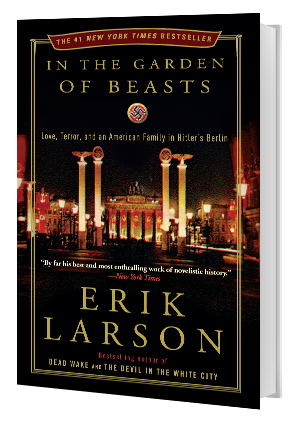
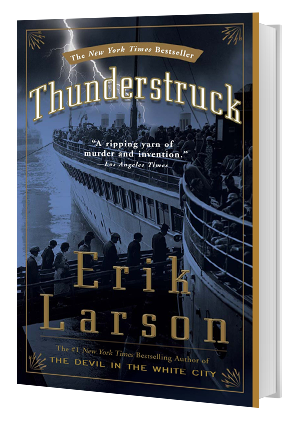
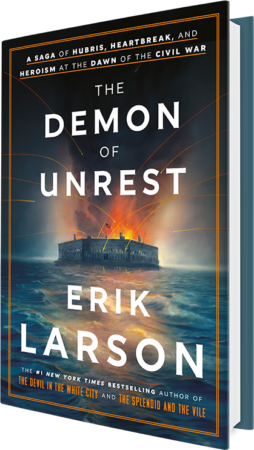
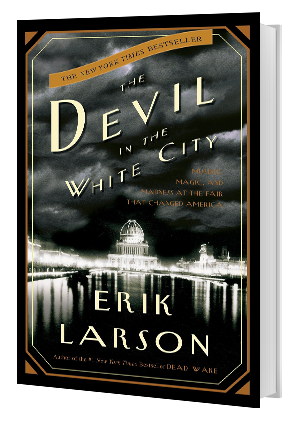
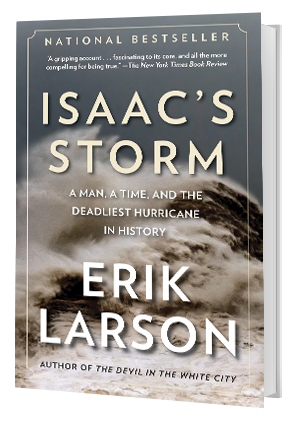
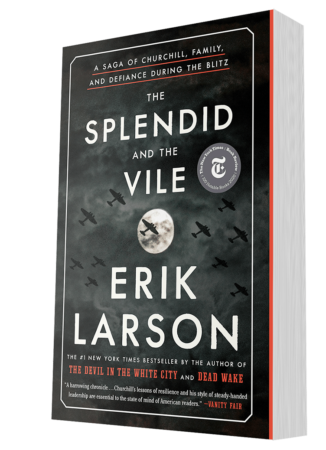
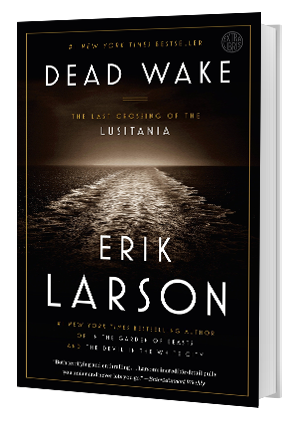
Good write up! I struggle to enjoy Erik Larson much, because like you said, the blurring of fact and fiction. I have stumbled across a couple historical books I have enjoyed that you might, too: American Phoenix by Jane Hampton Cook (more historical than fiction, I think) and Batavia by Peter FitzSimons (more like Larson’s books, I think, where he tries to paint a picture of what it probably was like/said, etc.). Fascinating bit of history, but pretty dark.
Excellent writer, enjoyable commentary, thank you!